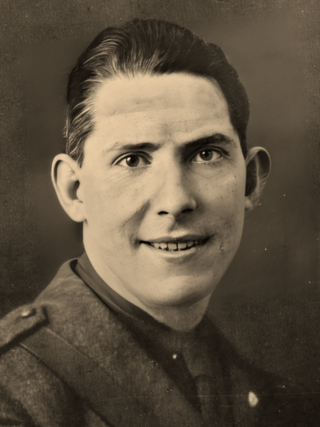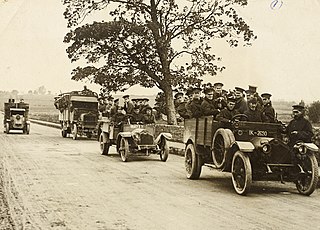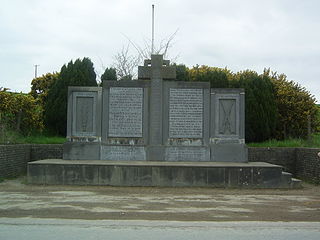
The Irish Republican Army was an Irish republican revolutionary paramilitary organisation. The ancestor of many groups also known as the Irish Republican Army, and distinguished from them as the "Old IRA", it was descended from the Irish Volunteers, an organisation established on 25 November 1913 that staged the Easter Rising in April 1916. In 1919, the Irish Republic that had been proclaimed during the Easter Rising was formally established by an elected assembly, and the Irish Volunteers were recognised by Dáil Éireann as its legitimate army. Thereafter, the IRA waged a guerrilla campaign against the British occupation of Ireland in the 1919–1921 Irish War of Independence.

Tom Maguire was an Irish republican who held the rank of commandant-general in the Western Command of the Irish Republican Army (IRA) and led the South Mayo flying column.

The Irish War of Independence or Anglo-Irish War was a guerrilla war fought in Ireland from 1919 to 1921 between the Irish Republican Army and British forces: the British Army, along with the quasi-military Royal Irish Constabulary (RIC) and its paramilitary forces the Auxiliaries and Ulster Special Constabulary (USC). It was part of the Irish revolutionary period.

Seán Mac Eoin was an Irish Fine Gael politician and soldier who served as Minister for Defence briefly in 1951 and from 1954 to 1957, Minister for Justice from 1948 to 1951, and Chief of Staff of the Defence Forces from February 1929 to October 1929. He served as a Teachta Dála (TD) from 1921 to 1923, and from 1929 to 1965.

Ballymahon on the River Inny is a town in the southern part of County Longford, Ireland. It is located at the junction of the N55 National secondary road and the R392 regional road.

The Auxiliary Division of the Royal Irish Constabulary (ADRIC), generally known as the Auxiliaries or Auxies, was a paramilitary unit of the Royal Irish Constabulary (RIC) during the Irish War of Independence. It was founded in July 1920 by Major-General Henry Hugh Tudor and made up of former British Army officers, most of whom came from Great Britain and had fought in the First World War. Almost 2,300 served in the unit during the conflict. Its role was to conduct counter-insurgency operations against the Irish Republican Army (IRA), acting mainly as a mobile striking and raiding force. It operated semi-independently of the RIC and was mainly deployed to southern and western regions where fighting was heaviest.
The Carrowkennedy ambush was an ambush carried out by the Irish Republican Army (IRA) on 2 June 1921, during the Irish War of Independence. An IRA flying column, commanded by Michael Kilroy, ambushed a mobile patrol of the Royal Irish Constabulary including Black and Tans recruits at Carrowkennedy, near Westport, County Mayo. It resulted in the deaths of seven of the RIC, including some who were killed by their own rifle grenade. After two hours the RIC surrendered and their weaponry and ammunition were seized by the IRA.
Ernest Bernard Malley was an Irish republican and writer. After a sheltered upbringing, he witnessed and participated in the Easter Rising of 1916, an event that changed his outlook fundamentally. O'Malley soon joined the Irish Volunteers before leaving home in spring 1918 to become an IRA organiser and training officer during the Irish War of Independence against British rule in Ireland. In the later period of that conflict, he was appointed a divisional commander with the rank of general. Subsequently, O'Malley strongly opposed the Anglo-Irish Treaty and became assistant chief of staff of the Anti-Treaty IRA during the Irish Civil War of 1922–23.

This is a timeline of the Irish War of Independence of 1919–21. The Irish War of Independence was a guerrilla conflict and most of the fighting was conducted on a small scale by the standards of conventional warfare.

The Crossbarry ambush or Battle of Crossbarry occurred on 19 March 1921 and was one of the largest engagements of the Irish War of Independence. It took place near the small village of Crossbarry in County Cork, about 20 km south-west of Cork city. About a hundred Irish Republican Army (IRA) volunteers, commanded by Tom Barry, escaped an attempt by about 1,200 British troops to encircle them. During the hour-long battle, ten British troops and three IRA volunteers were killed.
The Coolavokig ambush was carried out by the Irish Republican Army (IRA) on 25 February 1921, during the Irish War of Independence. It took place at Coolavokig, on the road between Macroom and Ballyvourney, County Cork. A 60-man flying column of the IRA's 1st Cork Brigade under Seán O'Hegarty, ambushed a 70-man convoy of the Auxiliary Division under Major Seafield Grant, sparking a four-hour battle. Ten Auxiliaries were killed, including Major Grant, and others wounded. The IRA column left the area when British reinforcements arrived. After the ambush, British forces stopped carrying out raids and patrols in the area.
The Scramoge ambush was an ambush carried out by the Irish Republican Army (IRA) on 23 March 1921, during the Irish War of Independence. The IRA ambushed a lorry carrying British troops and Royal Irish Constabulary (RIC) officers at Scramoge, near Strokestown in County Roscommon. Three British soldiers and an RIC officer were killed, while two RIC 'Black and Tans' were captured and shot dead shortly after.
The Clonfin Ambush was an ambush carried out by the Irish Republican Army (IRA) on 2 February 1921, during the Irish War of Independence. It took place in the townland of Clonfin between Ballinalee and Granard in County Longford. The IRA ambushed two lorries carrying members of the British Auxiliary Division, sparking a lengthy gun battle in which four Auxiliaries were killed and eight wounded. The Auxiliaries eventually surrendered and their weapons were seized. The IRA commander, Seán Mac Eoin, won some praise for helping the wounded Auxiliaries. Following the ambush, British forces burned a number of houses and farms in the area, and shot dead an elderly farmer.
The Sheemore ambush was an ambush carried out by the Irish Republican Army (IRA) on 4 March 1921, during the Irish War of Independence. It took place at Sheemore near Carrick-on-Shannon, County Leitrim.
The Burgery ambush was an ambush carried out by the Irish Republican Army (IRA) on 18–19 March 1921, during the Irish War of Independence. It took place near Dungarvan, County Waterford.
The Clonbanin ambush was an ambush carried out by the Irish Republican Army (IRA) on 5 March 1921, during the Irish War of Independence. It took place in the townland of Clonbanin, County Cork.
The Clonmult ambush took place on 20 February 1921, during the Irish War of Independence.
The Rineen ambush was an ambush carried out by the Mid Clare Brigade of the Irish Republican Army (IRA) on 22 September 1920, during the Irish War of Independence. The attack took place at Drummin Hill in the townland of Drummin, near the hamlet of Rineen, County Clare.
The Kilmeena ambush was an action during the Irish War of Independence that took place at Kilmeena, County Mayo on 19 May 1921. The ambush ended in defeat for the local West Mayo Irish Republican Army (IRA), with five IRA volunteers killed and four wounded and captured. Two members of the Royal Irish Constabulary (RIC) and one Black and Tan were also killed in the action.
The Tourmakeady ambush or Battle of Tourmakeady occurred on 3 May 1921 during the Irish War of Independence. The South Mayo Brigade of the Irish Republican Army (IRA), commanded by Commandant Tom Maguire ambushed an RIC/Black and Tan re-supply patrol in the village of Tourmakeady, County Mayo in the west of Ireland in order to destroy the patrol and to cause the closure of Derrypark RIC Barracks, seven miles to the south.







